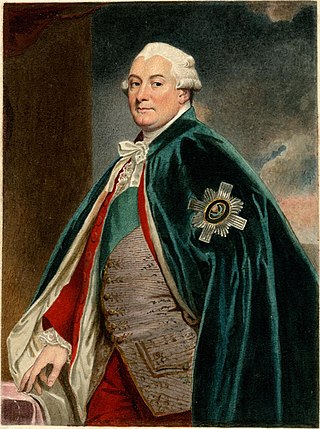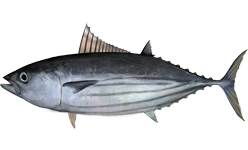
Actinopterygii, members of which are known as ray-finned fish or actinopterygians, is a class of bony fish that comprise over 50% of living vertebrate species. They are so called because of their lightly built fins made of webbings of skin supported by radially extended thin bony spines called lepidotrichia, as opposed to the bulkier, fleshy lobed fins of the sister class Sarcopterygii. Resembling folding fans, the actinopterygian fins can easily change shape and wetted area, providing superior thrust-to-weight ratios per movement compared to sarcopterygian and chondrichthyian fins. The fin rays attach directly to the proximal or basal skeletal elements, the radials, which represent the articulation between these fins and the internal skeleton.

Coelacanths are an ancient group of lobe-finned fish (Sarcopterygii) in the class Actinistia. As sarcopterygians, they are more closely related to lungfish and tetrapods than to ray-finned fish.

A tuna is a saltwater fish that belongs to the tribe Thunnini, a subgrouping of the Scombridae (mackerel) family. The Thunnini comprise 15 species across five genera, the sizes of which vary greatly, ranging from the bullet tuna up to the Atlantic bluefin tuna, which averages 2 m (6.6 ft) and is believed to live up to 50 years.

The walleye, also called the yellow pike or yellow pikeperch or yellow pickerel, is a freshwater perciform fish native to most of Canada and to the Northern United States. It is a North American close relative of the European zander, also known as the pikeperch. The walleye is sometimes called the yellow walleye to distinguish it from the blue walleye, which is a color morph that was once found in the southern Ontario and Quebec regions, but is now presumed extinct. However, recent genetic analysis of a preserved (frozen) 'blue walleye' sample suggests that the blue and yellow walleye were simply phenotypes within the same species and do not merit separate taxonomic classification.

A tetrapod is any four-limbed vertebrate animal of the superclass Tetrapoda. Tetrapods include all extant and extinct amphibians and amniotes, with the latter in turn evolving into two major clades, the sauropsids and synapsids. Some tetrapods such as snakes, legless lizards, and caecilians have evolved to become limbless via mutations of the Hox gene, although some do still have a pair of vestigial spurs that are remnants of the hindlimbs.

The Hay–Bunau-Varilla Treaty was a treaty signed on November 18, 1903, by the United States and Panama, which established the Panama Canal Zone and the subsequent construction of the Panama Canal. It was named after its two primary negotiators, Philippe-Jean Bunau-Varilla, the French diplomatic representative of Panama, and United States Secretary of State John Hay.

Gnathostomata are the jawed vertebrates. Gnathostome diversity comprises roughly 60,000 species, which accounts for 99% of all living vertebrates, including humans. In addition to opposing jaws, living gnathostomes have true teeth, paired appendages, the elastomeric protein of elastin, and a horizontal semicircular canal of the inner ear, along with physiological and cellular anatomical characters such as the myelin sheaths of neurons, and an adaptive immune system that has the discrete lymphoid organs of spleen and thymus, and uses V(D)J recombination to create antigen recognition sites, rather than using genetic recombination in the variable lymphocyte receptor gene.

David Murray, 2nd Earl of Mansfield, 7th Viscount of Stormont, known as the (7th) Viscount of Stormont from 1748 to 1793, was a British diplomat and politician. He succeeded to both the Mansfield and Stormont lines of the Murray family, inheriting two titles and two fortunes.

Holocephali, sometimes given the term Euchondrocephali, is a subclass of cartilaginous fish in the class Chondrichthyes. The earliest fossils are of teeth and come from the Devonian period. Little is known about these primitive forms, and the only surviving group in the subclass is the order Chimaeriformes.

Philippe-Jean Bunau-Varilla was a French engineer and soldier. With the assistance of American lobbyist and lawyer William Nelson Cromwell, Bunau-Varilla greatly influenced Washington's decision concerning the construction site for the Panama Canal. He also worked closely with President Theodore Roosevelt in the latter's orchestration of the Panamanian Revolution.

William Nelson Cromwell was an American attorney active in promotion of the Panama Canal and other major ventures especially in cooperation with Philippe Bunau-Varilla.

The skipjack tuna is a perciform fish in the tuna family, Scombridae, and is the only member of the genus Katsuwonus. It is also known as katsuo, arctic bonito, mushmouth, oceanic bonito, striped tuna or victor fish. It grows up to 1 m (3 ft) in length. It is a cosmopolitan pelagic fish found in tropical and warm-temperate waters. It is a very important species for fisheries.

Imperial Count Heinrich von Bünau was a politician and historian from the Electorate of Saxony, now part of Germany.

Barbodes is a genus of small to medium-sized cyprinid fish native to tropical Asia. The majority of the species are from Southeast Asia. Many species are threatened and some from the Philippines are already extinct. A survey carried out in 1992 only found three of the endemic Barbodes species, and only two were found in 2008. Several members of this genus were formerly included in Puntius.

The separation of Panama from Colombia was formalized on 3 November 1903, with the establishment of the Republic of Panama. From the Independence of Panama from Spain in 1821, Panama had simultaneously declared independence from Spain and joined itself to the confederation of Gran Colombia through the Independence Act of Panama. Panama was always tenuously connected to the rest of the country to the south, owing to its remoteness from the government in Bogotá and lack of a practical overland connection to the rest of Gran Colombia. In 1840–41, a short-lived independent republic was established under Tomás de Herrera. After rejoining Colombia following a 13-month independence, it remained a province which saw frequent rebellious flare-ups, notably the Panama crisis of 1885, which saw the intervention of the United States Navy, and a reaction by the Chilean Navy.
Maurice Bunau-Varilla was a French press magnate, and proprietor of the newspaper Le Matin. During the Second World War, he made the newspaper's editorial line pro-German and pro-collaborationist, and it ceased publication 16 days after his death. Bunau-Varilla admired Adolf Hitler more out of his anti-Communist leanings than out of Nazi conviction.

Betta is a large genus of small, active, often colorful, freshwater ray-finned fishes, in the gourami family (Osphronemidae). The best known Betta species is B. splendens, commonly known as the Siamese fighting fish and often kept as an aquarium pet.

Rudolf von Bünau was a German general in the Wehrmacht during World War II who commanded several corps. He was a recipient of the Knight's Cross of the Iron Cross with Oak Leaves of Nazi Germany. His son, also named Rudolf von Bünau, was awarded the Knight's Cross of the Iron Cross on 8 August 1943; he was killed in action just one week later on 15 August 1943 south of Roslavl. His other son, Günther von Bünau was also killed in action in 1943. Rudolf von Bünau would survive the war. He was interned by the Americans until April 1947. Rudolf was killed in a car crash in 1962.

German XI. Corps was a corps in the German Army during World War II.

Quantum ESPRESSO is a suite for first-principles electronic-structure calculations and materials modeling, distributed for free and as free software under the GNU General Public License. It is based on density-functional theory, plane wave basis sets, and pseudopotentials. ESPRESSO is an acronym for opEn-Source Package for Research in Electronic Structure, Simulation, and Optimization.


















